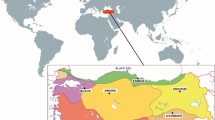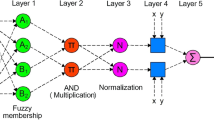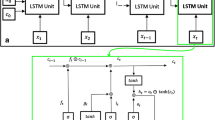Abstract
Atmospheric pressure (AP), which is an indicator of weather events, plays an important role in climatology, agriculture, meteorology, atmospheric and environmental science, human and animal life, and Earth’s living ecosystem. In this regard, accurate AP forecasting plays a crucial role in today’s life as it provides critical information about future weather events. In this study, four different machine learning techniques such as long short-term memory (LSTM) neural network, adaptive neuro-fuzzy inference system (ANFIS) with fuzzy c-means, ANFIS with subtractive clustering, and ANFIS with grid partition (GP) were used for one-hour-ahead AP forecasting. To achieve this, the hourly AP data measured between 2012 and 2019 at the seven measurement stations (Adana, Ankara, Gumushane, Denizli, Kirklareli, Sanliurfa, and Van) in different climate regions of Turkey were obtained. The estimation accuracy was verified by four performance criteria: R, RMSE, MAPE, and MAE. As a result, the highest relative R-value of 0.9986 and the lowest error values of RMSE = 0.2905 hPa, MAPE = 0.0230%, and MAE = 0.2040 hPa for one-hour-ahead AP forecasting were obtained from the ANFIS-GP model.









Similar content being viewed by others
References
Erdil A, Arcaklioglu E (2013) The prediction of meteorological variables using artificial neural network. Neural Comput Appl 22(7):1677–1683. https://doi.org/10.1007/s00521-012-1210-0
Tektaş M (2010) Weather forecasting using ANFIS and ARIMA models. Environ Res Eng Manag 51(1):5–10
Gaspar P, Ponte RM (1997) Relation between sea level and barometric pressure determined from altimeter data and model simulations. J Geophys Res Oceans 102(C1):961–971. https://doi.org/10.1029/96JC02920
Hossain M, Rekabdar B, Louis SJ, S Dascalu (2015) Forecasting the weather of Nevada: a deep learning approach. In 2015 international joint conference on neural networks (IJCNN) IEEE, pp 1–6. https://doi.org/10.1109/ijcnn.2015.7280812
La Rocca P, Riggi D, Riggi F (2010) Time series analysis of barometric pressure data. Eur J Phys 31(3):645. https://doi.org/10.1088/0143-0807/31/3/022
Abhishek K, Singh MP, Ghosh S, Anand A (2012) Weather forecasting model using artificial neural network. Procedia Technol 4:311–318. https://doi.org/10.1016/j.protcy.2012.05.047
Dutta B, Mitra S (2011) Better prediction of humidity using artificial neural network. In Fourth international conference on the applications of digital information and web technologies (ICADIWT 2011) IEEE, pp 59–64. https://doi.org/10.1109/ICADIWT.2011.6041395
Ray A, Mukhopadhyay S, Datta B, Pal S (2013) Prediction of atmospheric pressure at ground level using artificial neural network. Int J Res Comput Sci 3(1):11–18. https://doi.org/10.7815/ijorcs.31.2013.056
Mateus P, Catalão J, Mendes VB, Nico G (2020) An ERA5-based hourly global pressure and temperature (HGPT) Model. Remote Sens 12(7):1098. https://doi.org/10.3390/rs12071098
Li Q, Zhao Y, Yu F (2020) A novel multichannel Long Short-Term Memory Method with time series for soil temperature modeling. IEEE Access 8:182026–182043. https://doi.org/10.1109/ACCESS.2020.3028995
Althelaya KA, Mohammed SA, El-Alfy ESM (2021) Combining deep learning and multiresolution analysis for stock market forecasting. IEEE Access 9:13099–13111. https://doi.org/10.1109/ACCESS.2021.3051872
Eynard J, Grieu S, Polit M (2011) Wavelet-based multi-resolution analysis and artificial neural networks for forecasting temperature and thermal power consumption. Eng Appl Artif Intell 24:501–516. https://doi.org/10.1016/j.engappai.2010.09.003
He X, Guan H, Zhang X, Simmons CT (2014) A wavelet-based multiple linear regression model for forecasting monthly rainfall. Int J Climatol 34:1898–1912. https://doi.org/10.1002/joc.3809
Maslova I, Ticlavilca AM, McKee M (2016) Adjusting wavelet-based multiresolution analysis boundary conditions for long-term streamflow forecasting. Hydrol Process 30(1):57–74. https://doi.org/10.1002/hyp.10564
Jang JS (1993) ANFIS: adaptive-network-based fuzzy inference system. IEEE Trans Syst Man Cybern 23(3):665–685. https://doi.org/10.1109/21.256541
Karakuş O, Kuruoğlu EE, Altınkaya MA (2017) One-day ahead wind speed/power prediction based on polynomial autoregressive model. IET Renew Power Gener 11(11):1430–1439. https://doi.org/10.1049/iet-rpg.2016.0972
Mamdani EH, Assilian S (1975) 1975: An experiment in linguistic synthesis with a fuzzy logic controller. Int J Man Mach Stud 7(1):1–13. https://doi.org/10.1016/S0020-7373(75)80002-2
Mamdani EH (1977) Application of fuzzy logic to approximate reasoning using linguistic synthesis. IEEE Trans Comput C 26(12):1182–1191. https://doi.org/10.1109/TC.1977.1674779
Zadeh LA (1975) The concept of a linguistic variable and its application to approximate reasoning—I. Inf Sci 8:199–249. https://doi.org/10.1016/0020-0255(75)90036-5
MonirVaghefi H, Sandgani MR, Shoorehdeli MA (2013) Interval type-2 adaptive network-based fuzzy inference system (ANFIS) with type-2 non-singleton fuzzification. In: 13th Iranian conference on fuzzy systems (IFSC), pp 1–6. https://doi.org/10.1109/IFSC.2013.6675612
Takagi T, Sugeno M (1985) Fuzzy identification of systems and its applications to modeling and control. IEEE Trans Sys Man Cybern SMC 15(1):116–132. https://doi.org/10.1109/TSMC.1985.6313399
Kumar R, Al-Turjman F, Srinivas NB, Braveen M, Ramakrishnan J (2021) ANFIS for prediction of epidemic peak and infected cases for COVID-19 in India. Neural Comput Appl. https://doi.org/10.1007/s00521-021-06412-w
Bilgili M, Yildirim A, Ozbek A, Celebi K, Ekinci F (2021) Long short-term memory (LSTM) neural network and adaptive neuro-fuzzy inference system (ANFIS) approach in modeling renewable electricity generation forecasting. Int J Green Energy 18(6):578–594. https://doi.org/10.1080/15435075.2020.1865375
Ozbek A, Yildirim A, Bilgili M (2021) Deep learning approach for one-hour ahead forecasting of energy production in a solar-PV plant. Energy Sour Part A: Recovery Util Environ Eff. https://doi.org/10.1080/15567036.2021.1924316
Tabari H, Kisi O, Ezani A, Talaee PH (2012) SVM, ANFIS, regression and climate based models for reference evapotranspiration modeling using limited climatic data in a semi-arid highland environment. J Hydrol 444:78–89. https://doi.org/10.1016/j.jhydrol.2012.04.007
Katipoğlu OM (2022) Prediction of missing temperature data using different machine learning methods. Arab J Geosci 15(1):1–11. https://doi.org/10.1007/s12517-021-09290-7
Benmouiza K, Cheknane A (2019) Clustered ANFIS network using fuzzy c-means, subtractive clustering, and grid partitioning for hourly solar radiation forecasting. Theoret Appl Climatol 137(1):31–43. https://doi.org/10.1007/s00704-018-2576-4
Hochreiter S, Schmidhuber J (1997) Long short-term memory. Neural Comput 9(8):1735–1780. https://doi.org/10.1162/neco.1997.9.8.1735
Piotrowski AP, Napiorkowski MJ, Napiorkowski JJ, Osuch M (2015) Comparing various artificial neural network types for water temperature prediction in rivers. J Hydrol 529:302–315. https://doi.org/10.1016/j.jhydrol.2015.07.044
Salman AG, Heryadi Y, Abdurahman E, Suparta W (2018) Single layer & multi-layer long short-term memory (LSTM) model with intermediate variables for weather forecasting. Procedia Comput Sci 135:89–98. https://doi.org/10.1016/j.procs.2018.08.153
Zahroh S, Hidayat Y, Pontoh RS, Santoso A, Sukono F, Bon AT (2019) Modeling and forecasting daily temperature in Bandung. In Proceedings of the international conference on industrial engineering and operations management Riyadh, Saudi Arabia, pp 406–12
Cai Q, Yan B, Su B, Liu S, Xiang M, Wen Y, Cheng Y, Feng N (2020) Short-term load forecasting method based on deep neural network with sample weights. Int Trans Electr Energy Syst 30(5):1–19. https://doi.org/10.1002/2050-7038.12340
Cho MY, Chang JM, Huang CC (2020) Application of parallel Elman neural network to hourly area solar PV plant generation estimation. Int Trans Electr Energy Syst 30(8):1–19. https://doi.org/10.1002/2050-7038.12470
Mathworks (2020) Long Short-Term Memory Networks. https://www.mathworks.com/help/deeplearning/ug/long-short-term-memory-networks.html. Accessed 17 May 2020
Yan X, Weihan W, Chang M (2021) Research on financial assets transaction prediction model based on LSTM neural network. Neural Comput Appl 3:257–270. https://doi.org/10.1007/s00521-020-04992-7
Li W, Kiaghadi A, Dawson C (2021) High temporal resolution rainfall–runoff modeling using long-short-term-memory (LSTM) networks. Neural Comput Appl 33:1261–1278. https://doi.org/10.1007/s00521-020-05010-6
Zolfaghari M, Golabi MR (2021) Modeling and predicting the electricity production in hydropower using conjunction of wavelet transform, long short-term memory and random forest models. Renew Energy 170:1367–1381. https://doi.org/10.1016/j.renene.2021.02.017
Benhaddi M, Ouarzazi J (2021) Multivariate time series forecasting with dilated residual convolutional neural networks for urban air quality prediction. Arab J Sci Eng 46:3423–3442. https://doi.org/10.1007/s13369-020-05109-x
Peng J, Kimmig A, Wang J, Liu X, Niu Z, Ovtcharova J (2021) Dual-stage attention-based long-short-term memory neural networks for energy demand prediction. Energy Build 249:111211
Chen K, Kuang C, Wang L, Chen K, Han X, Fan J (2022) Storm surge prediction based on long short-term memory neural network in the East China Sea. Appl Sci 12:181. https://doi.org/10.3390/app12010181
Kurnaz G, Demir AS (2022) Prediction of SO2 and PM10 air pollutants using a deep learning-based recurrent neural network: case of industrial city Sakarya. Urban Clim 41:101051. https://doi.org/10.1016/j.uclim.2021.101051
Guleryuz D (2021) Estimation of soil temperatures with machine learning algorithms—Giresun and Bayburt stations in Turkey. Theoret Appl Climatol. https://doi.org/10.1007/s00704-021-03819-2
Acknowledgements
The authors wish to thank Turkish State Meteorological Service on account of supplying the data.
Author information
Authors and Affiliations
Corresponding author
Ethics declarations
Conflict of interest
All authors declare that they have no conflicts of interest.
Additional information
Publisher's Note
Springer Nature remains neutral with regard to jurisdictional claims in published maps and institutional affiliations.
Rights and permissions
About this article
Cite this article
Bilgili, M., Ilhan, A. & Ünal, Ş. Time-series prediction of hourly atmospheric pressure using ANFIS and LSTM approaches. Neural Comput & Applic 34, 15633–15648 (2022). https://doi.org/10.1007/s00521-022-07275-5
Received:
Accepted:
Published:
Issue Date:
DOI: https://doi.org/10.1007/s00521-022-07275-5




